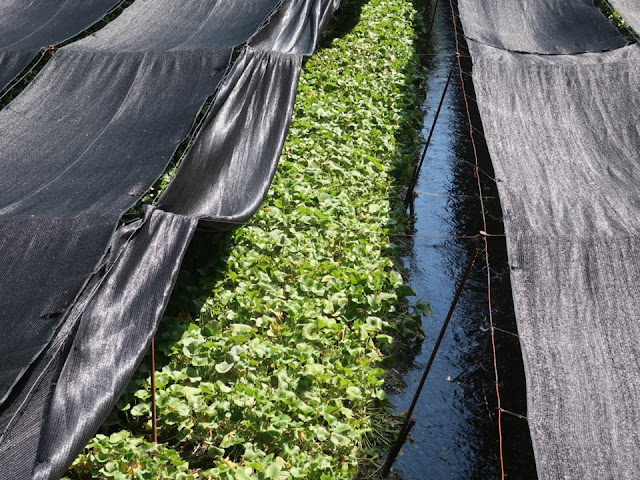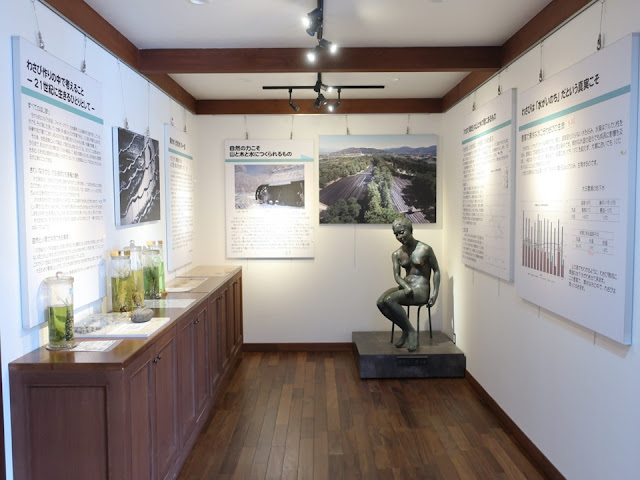The wasabi farm is in Azumino
city of Nagano prefecture (central Japan); it’s
also the best tourist attraction of the city. The pure underground water from
the Japanese Apls gush at the farm and show us beautiful streams. The
farm was developed in 1907, so we cannot find “Fun of Good Old Japanese” which
is the theme of this blog. However, the feel-good scenery has relaxed us.
長野県安曇野市きっての観光地でもある大王わさび農場は、清らかなアルプルの伏流水がわさび畑に流れる心地よい風景を見せてくれます。大正時代に開発された農場であり、本ブログのテーマの昔の人の楽しみというわけではないですが、昔も今もこれからも、人々の心も癒やしてくれる場所です。
The photo above is the wasabi farm. Wasabi plants are covered while sunlight is strong. The black sheets prevent water from increasing temperature. Many carp-shaped banners were hung when I visited in May; it is a custom of the Boys' Festival.
ここがわさび田です。日射が強い時期は水温の上昇を抑えるため黒いおおい(寒冷紗)がかけられます。5月に訪問したので、鯉のぼりが泳いでいました。
Wasabi grow under the sheets, and water in the furrows are supplied. The temperature of the spring water is around 13℃ all year long.
寒冷紗の下ではわさびが育ち、畝の間を湧水が流れています。湧き水の水温は一年中約13℃です。
It’s a tourist attraction but is an actual farm at the same time. We can see farmers are working.
観光地ですが農場なので、手入れをしている様子を見られます。
The Japanese Alps behind supply water to the farm. The buildings are establishments for tourists.
わさび田の先に見える北アルプスの山々。山の水が扇状地をくぐってこの地で湧き出てきます。左側にあるのは観光客むけのお店です。
The soft-serve ice cream (wasabi flavored) is popular. We tend to spend money because both admission and parking fee are free.
人気のわさびソフトクリーム。農場は入場料無料、駐車場無料なので、ついつい買ってしまいますね。
Spring waters flow into the river (Tadekawa). A water mill remains on the left. A renowned director (Kurosawa Akira) shot a short film here, “Village with a water wheel”. The scenery above brings Japanese people to bygone days.
湧水が集まる蓼川。美しい風景ですね。黒沢明監督がオムニバス映画「夢」の第八話「水車のある村」の撮影をした場所です。
Daio Wasabi Farm Centennial Memorial Hall、大王わさび農場百年記念館
The small museum was built in 2017, which was the hundredth anniversary of the farm.
2017年に開拓100年を記念して作られました。
History of wasabi and Daio Farm are displayed. There are plenty of trivia; people started eating raw fish with wasabi which has antibacterial ability in the Muromachi period (1338-1573), Hanaya Yohei (1799-1858) originated putting wasabi between sliced raw fish and rice ball seasoned with vinegar, sugar and salt, and so on. The land was a pear orchard before, but it was converted to a wasabi farm because of rich spring water.
わさびの歴史と大王わさび農場の誕生について書かれています。わさびを添えて生魚を刺身で食べるのは室町時代、鮨に載せたのは花屋与兵衛(1799 – 1858、にぎり鮨の考案者)などうんちくが一杯です。明治中期まで、この地は梨畑でしたが、湧水を生かしたわさび作りに転換しました。当時、わさびの大生産地は静岡でした。
There were no construction machines back then. Farmers dug channels and built banks. It was agricultural offseason (cold season). Their tools are displayed with photos. They started construction in 1917 and completed in 1935. It was a private business of Mr. Fukazawa. The second generation started tourism service.
Their efforts created the lovely scenery. It is an artificial site.
人力の時代でした。農閑期に農夫たちが寒さに耐えながら、湿地に水路を掘り、その土で堤防を築いていきました。開拓に使われた道具が写真と共に展示されています。1917年に開拓を開始し、1935年に完成。深澤氏の個人事業です。二代目が観光地として整備を進めました。
我々が見る心地よい景色は、このような努力の上にあるのですね。ここは人工の場所です。
The important role of water and so on are explained. Water is a lifeline of wasabi farming.
わさびと水、わさび自体の説明のコーナーもあります。水は生命線です。わさびのことがよく分かりますよ。
Rice planting was just finished. The senary is called “water-mirror”. You can see it on a windless day for several weeks until rice grow and cover field. Btw, many cars from the other prefectures parked and many foreigners visited. It is not only a farm but also a popular tourist spot.
田植えが終わったばかりの田んぼ。水面がアルプスの景色を写す水鏡も見られました。平日ですが、さすが、人気観光地、駐車場には県外からの車が多く、農場内にはたくさんの外国人観光客がいました。
Visited in May, 2023
Official website: https://www.daiowasabi.co.jp/en/
https://www.daiowasabi.co.jp/
(in Japanese), accessed in July, 2024
Previous post (museum in a upstream area of Azusagawa): Azusagawa・Academia Hall、梓川アカデミア館
Next post
(museum on the road from Matsumoto to the Sea of Japan): Omachi folklore museum、大町市民俗資料館
(Coming soon)













Comments
Post a Comment